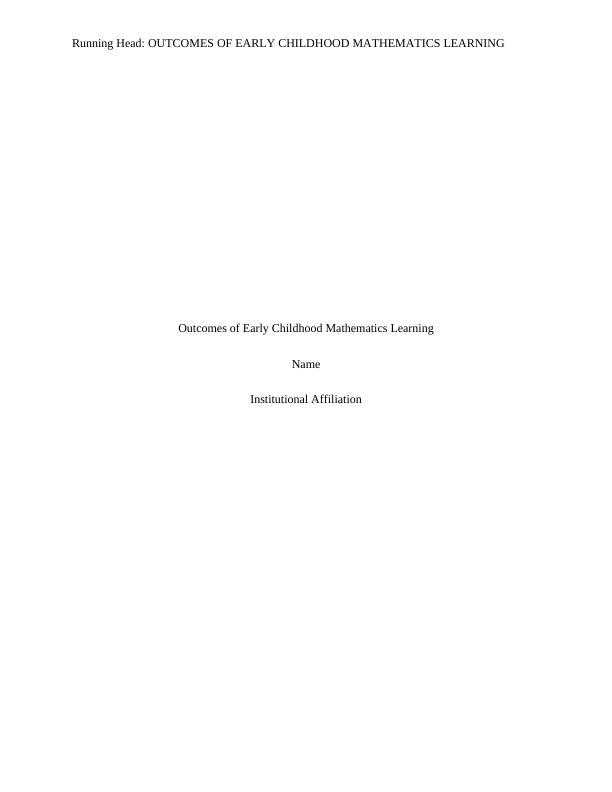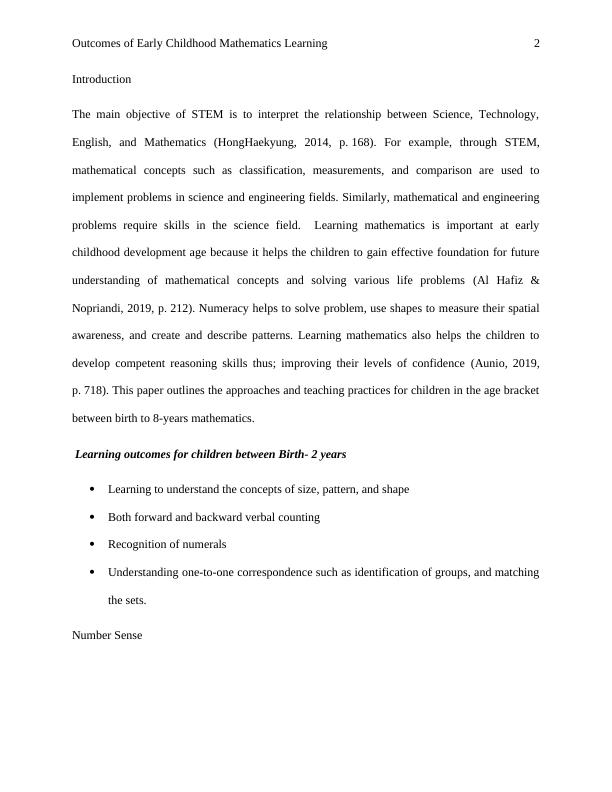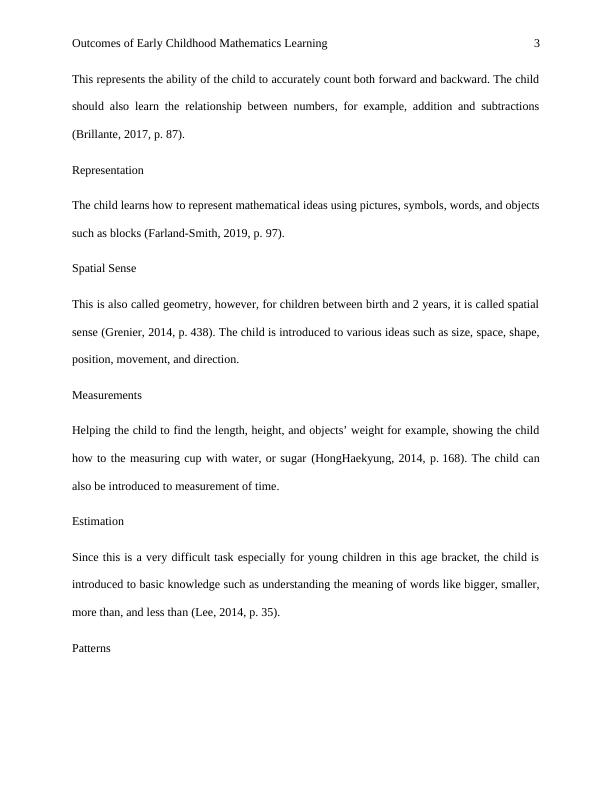Outcomes of Early Childhood Mathematics Learning
Added on 2023-04-19
14 Pages3010 Words439 Views
Running Head: OUTCOMES OF EARLY CHILDHOOD MATHEMATICS LEARNING
Outcomes of Early Childhood Mathematics Learning
Name
Institutional Affiliation
Outcomes of Early Childhood Mathematics Learning
Name
Institutional Affiliation

Outcomes of Early Childhood Mathematics Learning 2
Introduction
The main objective of STEM is to interpret the relationship between Science, Technology,
English, and Mathematics (HongHaekyung, 2014, p. 168). For example, through STEM,
mathematical concepts such as classification, measurements, and comparison are used to
implement problems in science and engineering fields. Similarly, mathematical and engineering
problems require skills in the science field. Learning mathematics is important at early
childhood development age because it helps the children to gain effective foundation for future
understanding of mathematical concepts and solving various life problems (Al Hafiz &
Nopriandi, 2019, p. 212). Numeracy helps to solve problem, use shapes to measure their spatial
awareness, and create and describe patterns. Learning mathematics also helps the children to
develop competent reasoning skills thus; improving their levels of confidence (Aunio, 2019,
p. 718). This paper outlines the approaches and teaching practices for children in the age bracket
between birth to 8-years mathematics.
Learning outcomes for children between Birth- 2 years
Learning to understand the concepts of size, pattern, and shape
Both forward and backward verbal counting
Recognition of numerals
Understanding one-to-one correspondence such as identification of groups, and matching
the sets.
Number Sense
Introduction
The main objective of STEM is to interpret the relationship between Science, Technology,
English, and Mathematics (HongHaekyung, 2014, p. 168). For example, through STEM,
mathematical concepts such as classification, measurements, and comparison are used to
implement problems in science and engineering fields. Similarly, mathematical and engineering
problems require skills in the science field. Learning mathematics is important at early
childhood development age because it helps the children to gain effective foundation for future
understanding of mathematical concepts and solving various life problems (Al Hafiz &
Nopriandi, 2019, p. 212). Numeracy helps to solve problem, use shapes to measure their spatial
awareness, and create and describe patterns. Learning mathematics also helps the children to
develop competent reasoning skills thus; improving their levels of confidence (Aunio, 2019,
p. 718). This paper outlines the approaches and teaching practices for children in the age bracket
between birth to 8-years mathematics.
Learning outcomes for children between Birth- 2 years
Learning to understand the concepts of size, pattern, and shape
Both forward and backward verbal counting
Recognition of numerals
Understanding one-to-one correspondence such as identification of groups, and matching
the sets.
Number Sense

Outcomes of Early Childhood Mathematics Learning 3
This represents the ability of the child to accurately count both forward and backward. The child
should also learn the relationship between numbers, for example, addition and subtractions
(Brillante, 2017, p. 87).
Representation
The child learns how to represent mathematical ideas using pictures, symbols, words, and objects
such as blocks (Farland-Smith, 2019, p. 97).
Spatial Sense
This is also called geometry, however, for children between birth and 2 years, it is called spatial
sense (Grenier, 2014, p. 438). The child is introduced to various ideas such as size, space, shape,
position, movement, and direction.
Measurements
Helping the child to find the length, height, and objects’ weight for example, showing the child
how to the measuring cup with water, or sugar (HongHaekyung, 2014, p. 168). The child can
also be introduced to measurement of time.
Estimation
Since this is a very difficult task especially for young children in this age bracket, the child is
introduced to basic knowledge such as understanding the meaning of words like bigger, smaller,
more than, and less than (Lee, 2014, p. 35).
Patterns
This represents the ability of the child to accurately count both forward and backward. The child
should also learn the relationship between numbers, for example, addition and subtractions
(Brillante, 2017, p. 87).
Representation
The child learns how to represent mathematical ideas using pictures, symbols, words, and objects
such as blocks (Farland-Smith, 2019, p. 97).
Spatial Sense
This is also called geometry, however, for children between birth and 2 years, it is called spatial
sense (Grenier, 2014, p. 438). The child is introduced to various ideas such as size, space, shape,
position, movement, and direction.
Measurements
Helping the child to find the length, height, and objects’ weight for example, showing the child
how to the measuring cup with water, or sugar (HongHaekyung, 2014, p. 168). The child can
also be introduced to measurement of time.
Estimation
Since this is a very difficult task especially for young children in this age bracket, the child is
introduced to basic knowledge such as understanding the meaning of words like bigger, smaller,
more than, and less than (Lee, 2014, p. 35).
Patterns

Outcomes of Early Childhood Mathematics Learning 4
The child is introduced to numbers, images, and shapes in repeated sequences to improve their
abilities to predict occurrences, logical creation of connections, and using reasoning and
competent skills (Menzer & Winsler, 2018, p. 195).
Problem-solving
The child is introduced to the concept of using the past knowledge and logical thinking to
provide a solution to a problem (Méndez, Hammer, Lopez, & Blair, 2019, p. 258).
Mathematical Concepts of Learning Experience
Exposing the child to stories, songs, use of repletion, rhymes, and numbers.
Cognitive and Development of Mathematical Concepts
Grasping and releasing objects, using sensorimotor approach and mental representation to
manipulate internal depictions such as pictures, concepts, spaces and grouping of objects. The
children falling between 10-12 can also use analogical techniques of solving problems
(HongHaekyung, 2014, p. 168),
Children between 2-3 years
Learning Outcomes
Learning outcomes for the children in this age bracket is similar to those between birth and 2
years (Méndez, Hammer, Lopez, & Blair, 2019, p. 196) such as;
Learning to understand the concepts of size, pattern, and shape
Both forward and backward verbal counting
Recognition of the numerals
The child is introduced to numbers, images, and shapes in repeated sequences to improve their
abilities to predict occurrences, logical creation of connections, and using reasoning and
competent skills (Menzer & Winsler, 2018, p. 195).
Problem-solving
The child is introduced to the concept of using the past knowledge and logical thinking to
provide a solution to a problem (Méndez, Hammer, Lopez, & Blair, 2019, p. 258).
Mathematical Concepts of Learning Experience
Exposing the child to stories, songs, use of repletion, rhymes, and numbers.
Cognitive and Development of Mathematical Concepts
Grasping and releasing objects, using sensorimotor approach and mental representation to
manipulate internal depictions such as pictures, concepts, spaces and grouping of objects. The
children falling between 10-12 can also use analogical techniques of solving problems
(HongHaekyung, 2014, p. 168),
Children between 2-3 years
Learning Outcomes
Learning outcomes for the children in this age bracket is similar to those between birth and 2
years (Méndez, Hammer, Lopez, & Blair, 2019, p. 196) such as;
Learning to understand the concepts of size, pattern, and shape
Both forward and backward verbal counting
Recognition of the numerals

End of preview
Want to access all the pages? Upload your documents or become a member.
Related Documents
Effect of Playing Building Blocks in Early Childhood Developmentlg...
|10
|2554
|20
Mathematical Tasks for 2-5 Years Children: Creating a Mathematically Rich Environment, Play-Based Activities, and Group Learninglg...
|10
|2115
|479
Science and Technology in Early Childhood Educationlg...
|4
|784
|63
Developing Concept of Math in Early Childhoodlg...
|8
|768
|184
Math and Science Education.lg...
|4
|620
|12
JANUARY2020 - Early Childhood Learninglg...
|9
|1123
|16
